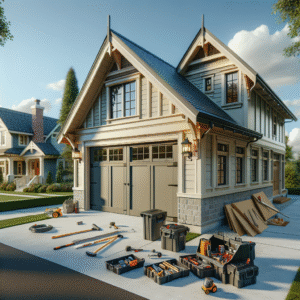Welcome to our comprehensive guide on Concrete Driveway Maintenance! Whether you’re looking to enhance the curb appeal of your home or extend the lifespan of your driveway, understanding the essentials of concrete care is crucial. A well-maintained driveway not only boosts your home’s aesthetics but also adds to its value. Here at BuildNet, we’re dedicated to helping you keep your driveway in pristine condition with practical tips and expert advice.
Introduction to Concrete Driveway Maintenance: Ensuring Longevity and Aesthetics
Maintaining your concrete driveway is not just about keeping it looking good; it’s also about preventing the need for costly repairs down the line. Exposure to harsh weather, the weight of vehicles, and everyday wear and tear can take a toll on your driveway. However, with the right maintenance strategies, you can protect your investment and keep your driveway looking as good as new for years to come.
Preventative Measures and Regular Maintenance: The Key to a Durable Concrete Driveway
Consistent upkeep is essential for prolonging the life of your driveway. Here are some preventative measures to help you maintain your concrete driveway:
- Regular Cleaning: Keep your driveway clean from dirt, debris, and stains caused by oil or grease.
- Sealing: Apply a high-quality sealer every two to three years to protect the concrete from moisture penetration, chemicals, and other harmful elements.
- Avoid Chemicals: Chemicals such as de-icing salts can damage concrete. Use safer alternatives like sand for traction in the winter.
Repair Techniques for Common Concrete Driveway Issues: Cracks, Discoloration, and Potholes
Even with diligent maintenance, issues can arise. Here’s how to address common problems:
- Cracks: Small cracks can be filled with a concrete crack filler or sealer to prevent water infiltration and further damage.
- Discoloration: Clean discolored areas with a mild detergent and a stiff brush or consider a professional concrete cleaning service for stubborn stains.
- Potholes: For larger problems like potholes, partial or full-depth repair may be necessary.
By following these tips and regularly inspecting your driveway for signs of wear and tear, you can ensure its longevity and aesthetic appeal. Stay tuned for more insights and solutions for keeping your concrete driveway in top condition!

If you’re ready to take your home improvement or construction project to the next level, we can help! Find trusted contractors on BuildNet, whether you’re looking for renovations, new builds, electrical work, plumbing, or anything in between. Our directory connects you with qualified professionals who can make your vision a reality.
Introduction to Concrete Driveway Maintenance: Ensuring Longevity and Aesthetics
Welcome to the essential guide for maintaining your concrete driveway, brought to you by BuildNet, your trusted resource for local contracting and home services. Whether you’ve just installed a new driveway or are looking to refresh an existing one, understanding the basics of concrete maintenance is key to preserving its functionality and enhancing your home’s curb appeal. Let’s dive into some expert tips and practices that will keep your driveway in top shape for years to come!
Understanding the Basics of Concrete Durability
Concrete is favored for driveways due to its durability and longevity. However, like any other material, it requires some TLC to maintain its strength and visual appeal. Factors such as weather conditions, the amount of vehicle traffic, and exposure to chemicals can impact its condition over time. By adopting a proactive maintenance routine, you can help prevent common issues such as cracking, scaling, and discoloration.
Seasonal Maintenance Tips
Maintaining your concrete driveway involves regular checks and balances throughout the year. Here’s how you can tailor your maintenance routine to fit seasonal changes:
Spring:
- Inspection: Start with a thorough inspection to identify any damage from winter. Look for cracks or signs of water seepage.
- Cleaning: Power wash to remove dirt and salts that have accumulated over the winter months, which can cause scaling and spalling.
Summer:
- Sealant Application: Consider applying a high-quality sealant to protect your driveway from UV rays and moisture penetration.
- Weed Control: Remove any weeds that start to sprout through cracks to prevent further damage.
Fall:
- Debris Clearance: Keep your driveway clear of leaves and other debris to prevent staining and moisture retention.
- Minor Repairs: Fix small cracks and damages before they expand with colder temperatures.
Winter:
- Protection from Deicers: Avoid using deicing chemicals that can cause surface damage. Opt for sand or cat litter for traction.
- Snow Removal: Use a plastic shovel or a snow blower to clear the snow without scratching the concrete surface.
The Importance of Proper Cleaning Techniques
Cleaning your concrete driveway regularly not only enhances its appearance but also extends its lifespan. Here are some practical steps for effective cleaning:
- Regular Sweeping: Sweep your driveway frequently to prevent dirt and debris from accumulating and causing stains or mildew growth.
- Stain Removal: Treat oil stains and other spills with appropriate cleaning solutions as soon as possible. Baking soda and dish soap can be effective for mild stains, while commercial degreasers may be needed for tougher stains.
- Pressure Washing: For a deeper clean, consider using a pressure washer annually. This removes built-up grime, mildew, and other residues.
Sealing: A Shield Against the Elements
Sealing your concrete driveway is crucial in protecting it from moisture penetration, chemical corrosion, and cracks. A good quality sealant can also enhance the color of your concrete, making it look more vibrant. It’s recommended to apply a sealant every two to three years, depending on your local climate and the level of vehicle traffic. Here are a few tips on sealing:
- Choose the Right Sealant: Use a sealant appropriate for exterior concrete surfaces. Silane and siloxane-based sealers are popular choices for their deep penetration and water-repelling properties.
- Application Conditions: Apply the sealant in dry conditions when the temperature is between 50°F and 90°F.
- Even Application: Use a roller or sprayer to apply the sealant evenly. Avoid pooling to ensure that it dries uniformly.
By incorporating these maintenance routines, you can not only ensure the longevity of your concrete driveway but also retain its aesthetic appearance, enhancing the overall look and value of your property. Remember, a little care goes a long way in safeguarding your investment in a concrete driveway.

Preventative Measures and Regular Maintenance: The Key to a Durable Concrete Driveway
Hey there! If you’re the proud owner of a concrete driveway, you know it’s more than just a place to park your car. It’s an investment in your home’s curb appeal and functionality. Keeping it in top shape not only adds to your home’s beauty but also prevents long-term damage, saving you money and headaches down the line. Let’s dive into some essential preventative measures and regular maintenance tips that will keep your driveway looking pristine and performing well for years to come.
Start with the Basics: Routine Cleaning
Regular cleaning is the first step in maintaining the integrity of your concrete driveway. Over time, dirt, debris, and stains can accumulate, which not only affects the appearance but can also cause deterioration. Here’s how to keep it clean:
- Sweep regularly: Use a stiff broom to remove leaves, dirt, and other debris.
- Pressure washing: A yearly pressure wash can help keep your driveway looking fresh and prevent growth of moss and weeds.
- Stain removal: Treat oil spots, tire marks, and other stains promptly using appropriate concrete cleaners.
Seal the Deal with Sealer
Applying a high-quality sealer is a critical step in protecting your concrete driveway from moisture penetration, chemicals, oil, and other harmful substances. It also enhances the color of your concrete, if you’ve opted for a decorative type. Here’s what you need to know about sealing:
- Type of sealer: Choose a sealer based on your climate and the specific needs of your driveway. A silane or siloxane-based sealer is great for most environments.
- Application frequency: Typically, you should reseal your concrete driveway every two to three years, but this can vary based on weather conditions and the amount of vehicle traffic.
- Application tips: Make sure the driveway is clean and dry before applying the sealer. Apply in temperatures above 50°F and ensure there’s no rain forecast for at least 24 hours.
Managing Cracks Before They Expand
Cracks in your concrete driveway can be more than just an eyesore; they can develop into larger problems if not addressed quickly. Here’s how to tackle them:
- Regular inspections: Walk your driveway regularly to check for any signs of cracking.
- Early intervention: Fill small cracks with a flexible concrete crack filler or sealant as soon as you notice them.
- Professional help: For larger cracks or heaving, consider getting a professional evaluation from a local contractor to determine the underlying cause and best repair method.
Avoiding Water Damage
Water is a significant enemy of concrete driveways, especially in areas with freeze-thaw cycles. Here are some tips to ensure water doesn’t compromise the integrity of your driveway:
- Proper drainage: Make sure your driveway slopes away from your house and that water can run off efficiently to prevent pooling.
- Clean gutters: Keep nearby gutters clean and ensure downspouts direct water away from the driveway.
- Avoid deicers: In winter, avoid using deicing chemicals as they can damage concrete surfaces. Opt for sand for traction or use a concrete-safe deicer if necessary.
Keeping It Green
Maintaining your driveway isn’t just about using hard chemical cleaners. You can adopt eco-friendly practices to protect both your driveway and the environment:
- Use eco-friendly cleaners: Opt for phosphate-free soaps or cleaners specifically designed to be safe on concrete and harmless to plant life.
- Smart landscaping: Consider landscaping with native plants around your driveway to prevent erosion and runoff, while also promoting local biodiversity.
- Permeable paving: If considering a new installation or a major overhaul, think about permeable paving options that allow water to seep through and reduce runoff.
By implementing these preventative measures and sticking to a regular maintenance schedule, you can significantly extend the life of your concrete driveway while keeping it looking its best. Remember, a little effort goes a long way and the benefits of a well-maintained driveway include not only aesthetic appeal but also increased property value. It’s all about taking the right steps at the right time to avoid future problems. Happy maintaining!
Repair Techniques for Common Concrete Driveway Issues: Cracks, Discoloration, and Potholes
Hey there! Dealing with a concrete driveway that’s seen better days? Whether it’s cracks, discoloration, or those dreaded potholes, each issue can make your driveway look a little less inviting. But don’t worry! I’m here to walk you through some tried-and-true repair techniques that’ll bring your driveway back to its former glory. Let’s dive into the world of concrete repairs and see how you can keep your driveway in top shape!
1. Fixing Cracks in Your Concrete Driveway
Cracks in concrete driveways can be a common sight, but they’re also one of the easiest problems to fix. Here’s how you can handle them:
a. Clean the Crack
First, grab a broom or a leaf blower and clean out the crack. Remove any debris, dirt, or plants to ensure the repair material adheres properly.
b. Choose the Right Filler
For smaller cracks, a concrete crack sealant usually does the trick. You can find these in a caulk-like tube. For larger cracks, you might need a concrete patching compound.
c. Apply the Filler
Follow the manufacturer’s instructions to apply the filler. For sealants, you’ll usually use a caulking gun, and for patch compounds, a trowel will be necessary to press the compound into the crack and smooth it over.
d. Let It Cure
Give the filler ample time to cure, which can vary based on the product. Avoid using the driveway during this period.
2. Tackling Discoloration of Concrete Driveways
Discoloration can be a bit trickier than cracks, but it’s definitely manageable. Here’s how you can brighten up your driveway:
a. Identify the Cause
Concrete discoloration can be caused by a variety of factors including weather conditions, irregular curing, or even the type of concrete mix used. Knowing the cause can help pinpoint the best solution.
b. Clean the Surface
Start with a thorough cleaning. Use a power washer if available, or you can scrub the surface with a mixture of water and mild detergent.
c. Apply a Concrete Brightener
Concrete brighteners are available at most hardware stores and can help restore the original color. Follow the instructions carefully.
d. Consider Sealing
Once you’ve tackled the discoloration, applying a concrete sealant can help prevent future stains and fading.
3. Repairing Potholes in Concrete Driveways
Potholes are not just a nuisance, but they can also be dangerous. Here’s how to fix them:
a. Remove the Debris
Like with cracks, start by clearing out any debris from the pothole. This includes stones, loose concrete bits, and dirt.
b. Apply a Pothole Filler
Use a commercial pothole filler designed for concrete. These often come ready to use and simply need to be poured into the hole.
c. Compact the Filler
After pouring the filler, use a tamper or the back of a shovel to compact the filler into the pothole, ensuring it is level with the surrounding surface.
d. Allow for Curing
Allow the filler to cure as per the instructions. Avoid using the driveway during this time to ensure the filler sets properly.
Repairing your concrete driveway doesn’t have to be a daunting task. With the right tools and a bit of elbow grease, you can keep your driveway looking great for years to come. Remember, regular maintenance is key to avoiding larger issues down the road, so keep an eye on those minor cracks and slight discolorations before they turn into bigger headaches. Happy repairing!

FAQ: Maintaining Your Concrete Driveway
What regular maintenance does a concrete driveway require?
Maintaining your concrete driveway involves regular cleaning and periodic sealing. Sweeping the driveway to remove debris and washing it with a hose to remove dirt and spills helps prevent staining and deterioration. Applying a high-quality concrete sealer every few years can also protect the surface from wear, weather conditions, and oil leaks.
How often should I seal my concrete driveway?
It’s recommended to seal a concrete driveway every 2 to 3 years, depending on the climate and usage. Sealing can extend the life of your driveway by providing a protective layer that resists water penetration, UV rays, and chemical attacks.
What are the best methods to remove stains from a concrete driveway?
To remove stains from your concrete driveway, first identify the type of stain. Oil and grease stains can be cleaned using degreasing agents or baking soda. For rust stains, a solution of vinegar or a commercial rust remover can be effective. Always test a small area first to ensure there is no discoloration.
Can cracks in concrete driveways be repaired?
Yes, cracks in concrete driveways can be repaired to prevent further damage. Small cracks can be filled with a concrete crack filler or caulk designed for concrete. For larger cracks, a concrete patching compound may be necessary. If the cracking is extensive, it might be advisable to consult a professional.
How do I prevent weeds from growing on my concrete driveway?
Preventing weeds starts with proper installation and maintenance. Ensure that the edges of your driveway are well-sealed, and consider using a weed barrier around its perimeter. Regularly remove any debris and use a natural weed killer or vinegar solution for any sprouts that appear.
What causes potholes in concrete driveways and how can they be fixed?
Potholes in concrete driveways can be caused by water erosion underneath the concrete due to poor drainage or cracked surfaces allowing water penetration. They can be fixed by cleaning out the pothole, filling it with an appropriate pothole repair mix, and compacting the material. If drainage is an issue, addressing that will also be crucial to prevent future problems.
Is it better to repair or replace a damaged concrete driveway?
Whether to repair or replace a concrete driveway depends on the extent of the damage and the age of the driveway. Minor cosmetic issues or small cracks can typically be repaired. However, if the driveway has multiple large cracks, potholes, or signs of subsidence, replacing it might be more cost-effective in the long run.
How does the climate affect concrete driveway maintenance?
Climate plays a significant role in the maintenance needs of a concrete driveway. In colder climates, freeze-thaw cycles can cause cracking and heaving, while in hot climates, UV exposure can degrade the sealer more quickly. Tailoring your maintenance routine to your climate is essential for protecting your investment.
Conclusion
Maintaining your concrete driveway is essential not just for its appearance but also for extending its lifespan. Regular cleaning, sealing, and timely repairs can prevent small issues from becoming expensive problems. At BuildNet, we understand that sometimes the task might seem daunting or you may require professional help.
Whether you’re looking at minor repairs or a full driveway replacement, our directory of experienced local contractors is at your fingertips. Each contractor is vetted to ensure you receive quality service tailored to your needs. Don’t hesitate to contact a contractor on the BuildNet website for a free quote. Maintaining your driveway is an investment in your property’s value and curb appeal, so take the first step today and ensure your driveway remains in prime condition for years to come!







